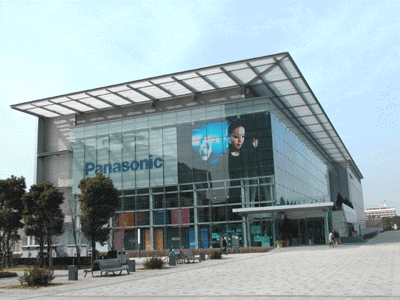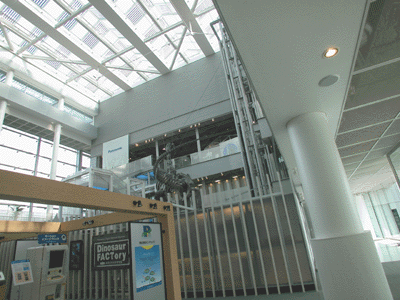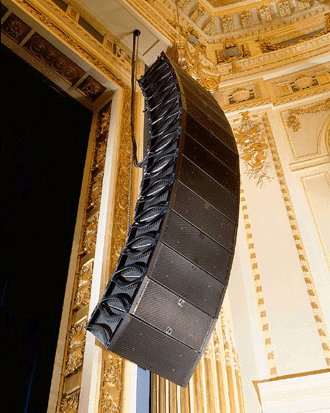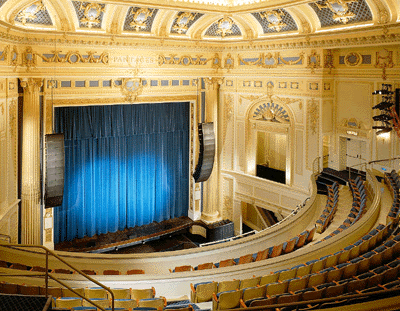
Title means "Quietness", "Comfortable Sound" and "Excellent Acoustics"
Nagata Acoustics News 03-03 (No.183)
Issued : March 25, 2003
Matsushita Electric's New Panasonic Center Focuses on Ubiquitous Information Networking
by Toshiko Fukuchi
Panasonic Center exterior
 |
In September 2002, Matsushita Electric's new "Panasonic Center" became the latest addition to Tokyo's fast-developing Rinkai Ward, which is located along the coast of Tokyo Bay. Just as Panasonic Center focuses on displaying new technologies that will create a "ubiquitous network society" fully integrated into our daily lives, the complex, too, is well integrated into its neighborhood, as it is located alongside the Tokyo Rinkai high speed rail line's Kokusai-tenjijo (International Exhibition Hall) Station.
The new Center includes two buildings: a main complex and an annex. The main complex building, located on the train-station side of the Center's land, has a glass exterior and three floors open to the public. Here, the latest and greatest Panasonic-brand audio, digital network, life-style and environmentally friendly, "green" products are displayed in an attractive showroom-like setting. Adjacent to the main complex, and next to an old battery building, stands the annex building, which houses Matsushita Electric's new TV and audio-visual recording studio, named Ariake Studio. The studio's equipment implements the newest advances in digital technologies and broadband capabilities in addition to providing the artists and others who work there with home-cooked meals made in a state-of-the art kitchen outfitted with Matsushita Group kitchen appliances. The studio and the fourth floor of the main building are reserved for business and professional use and are not open to the general public.
<< Panasonic Center Project Participants >>
Nihon Sekkei Inc. created the Center's architectural design and the project's construction contractor was Taisei Corporation. Nagata Acoustics had responsibility for the acoustical design of Ariake Studio and also oversaw aspects of the construction phase that would affect the studio's acoustics. Of course, Matsushita Group companies supplied all of the Center's mechanical, electrical and special equipment needs and representatives from these companies also participated in the project's construction.
<< Panasonic Center Implements the Matsushita Vision for the Future >>
According to literature distributed at the Center's opening and now available on the Center's website, a goal of Panasonic Center is to exhibit products exemplifying new technologies that help realize the Matsushita Group's dual vision of a "ubiquitous network society" and "coexistence with the global environment." Visitors to the Center can view displays of products and handle and try some of them, as well as provide feedback that Matsushita Electric says it will use as input for future product ideas and designs.
Dinosaur FACTory
 |
Matsushita Electric's press release about Panasonic Center explains that "ubiquitous network society" means a world in which "information terminals such as digital televisions, mobile phones and car navigation systems will eventually become integrated into every aspect of daily life and a sophisticated information network environment will evolve." A huge video information display panel, dubbed "Astrowall," installed on the outside of the Center's main complex, and the Digital Network Museum (aka Hayashibara Museum of Natural Science "Dinosaur FACTory") on this building's first and third floors, offer proof that some aspects of Matsushita Electric's futuristic vision exist even today.
Panasonic Center also implements some Matsushita Electric "green" technologies, demonstrating the viability of the company's "coexistence with the global environment" vision. Specifically, the Center uses a solar system for part of its energy needs and a Matsushita Electric, fuel cell-driven co-generation system. In addition, the Center has a system to capture and utilize rainwater. The building's design allows the visiting public to view these systems in operation as well as experience being in an environment that uses "green-generated" electricity and "green-sourced" water.
<< Panasonic Center's Ariake Studio >>
Panasonic Center's Ariake Studio was jointly funded by the Japanese theater and TV production company, Yoshimoto Kogyo, and Matsushita Electric. A joint venture named Ariake Studio is responsible for the studio's day-to-day operations. The studio's opening-day literature emphasized the studio's commitment to maximizing the opportunities provided by broadband technologies. In addition to using equipment with today's most advanced technologies and experimenting with technologies and products still in the prototype stage, the studio's literature indicates that Ariake Studio intends to create content for productions distributed via broadband connections as well as serve as a recording studio.
<< Ariake Studio's Building Layout >>
The Ariake Studio building contains two studios. The larger Studio "A" measures approximately 496 sq. m. (5,337 sq. ft) and Studio "B" is 100 sq. m. (1,071 sq. ft). The two studios are only separated from each other by a corridor. On a balcony level above Studio "B" are supplemental control rooms and announcers' booths for both studios, and the HVAC and machine room is located above the second-floor balcony.
<< External Noise and Vibration at the Studio Site >>
A major elevated Tokyo road artery, Kosoku-doro Wangan-sen ("High-speed Bay Artery") passes along the north end of the Ariake Studio site. In addition, the subterranean Tokyo Rinkai high-speed train line runs so close to the north border of the site that it virtually grazes the edge of the property.
At the start of the project's construction, we measured the noise level at the studio site and obtained an equivalent sound level (Leq) of 71 dB(A). Inside the temporary structure built parallel to the elevated road artery for the construction company's use, the ambient noise was loud enough to make normal conversation difficult. In addition, through our evaluation of the site, we were able to predict that the accelerating vibration level from passing trains would produce detectable levels of solid-borne sound. Since these kinds of external noise and vibration conditions are at odds with the quietness required in recording studios, Nagata Acoustics began our participation during the building's earliest design stages in order to include anti-noise and anti-vibration strategies in the building's structural design. Our anti-noise and anti-vibration strategy began with the use of reinforced concrete for the building's frame and insertion of anti-vibration rubber material in the structural foundation of both studios.
<< Electro-magnetic shielding and Acoustic Design Needs >>
Electro-magnetic shielding is an essential and standard element in the construction of recording studios. Naturally, the Ariake Studio's building design included electro-magnetic shielding for both of Ariake Studio's studios as well as the control room. The most difficult part of electro-magnetic shielding construction is at openings in the studio. The areas around doors, shutter doors, electrical outlets, air ducts and any other openings in the walls all require careful attention, and every crevice must be covered with electro-magnetic shielding. For Nagata Acoustics, proper sealing of openings and crevices was critical to our anti-noise and anti-vibration strategy. Therefore, the electro-magnetic shielding engineer and Nagata Acoustics shared a critical interest in how the areas around the studio doors and other openings would be constructed and sealed. The negotiations on this aspect of the project required many hours of work in order to devise construction plans that satisfied both the electro-magnetic shielding and acoustical needs of the project.
One item that required compromise was the use of a shutter door. Basically, it is apparently difficult to achieve satisfactory electro-magnetic shielding performance when shutter doors are installed in a room. However, the client wanted a large opening to the studios, and the project needed to weigh the electro-magnetic shielding requirement against the project schedule and cost constraints. The decision was made to implement a shutter door for the large opening. I understand that after the completion of construction, adjustments were made that enabled the originally specified electro-magnetic shielding performance level to also be achieved.
<< Acoustical Performance Levels of the Completed Studios >>
The completed studios achieved the following acoustical performance levels. In both Studio "A" and "B," there is absolutely no detection of noise from either the high-speed roadway or the train line, even when the HVAC system is turned off. We successfully achieved the goals of NC-25 for Studio "A," and of NC-20 for Studio "B."
For the sound isolation between Studio "A" and Studio "B," we achieved a variance of 99 dB (at 500 Hz) between the sound level in the studio where the sound is generated and the sound level in the other studio. This variance means that both studios can be used simultaneously without any noise impediment.
In the six months that the studios have been in operation, there has not been even one complaint about the studios' acoustics or noise and sound isolation performance. The client's satisfaction with the completed project is, of course, what is always most important.
<< The Uniqueness of Studio Construction Projects >>
While this was not my first recording studio project, Ariake Studio was my first studio project for use by TV professionals and audio-visual technicians working at the cutting edge of recording technology. It was an opportunity for me to learn a great deal about this specialty construction area, and I was grateful that many of the project construction participants were seasoned veterans of studio construction. I benefited greatly from their suggestions and support.
In particular, while working on accommodating the need to build electro-magnetic shielding, I was impressed with how different that technology and its methods are, despite the fact that both electro-magnetic shielding and acoustics address wave phenomena.
I wish to make note that Taisei Corporation's research organization provided valuable technical support in the negotiations on the electro-magnetic shielding. In addition, Taisei Corporation also performed the post-construction acoustical measurements. These measurements are the source of the acoustical performance measurements I quoted in the above paragraphs.
The Panasonic Center website (http://www.panasonic-center.com/) provides more information about the center, in English as well as Japanese. The Ariake Studio website (http://www.ariake-studio.com/ ) has Japanese text only, but there are floor plans and photos of the studios that are well worth viewing.
Trends in Hall Loudspeakers
by Motoo Komoda
I have written about a number of hall loudspeaker topics for previous editions of our News and Opinions website. This is a continuously evolving field, and in this article I will focus on a small assortment of current issues and strategies.
<< Hall-specific Loudspeaker Requirements >>
Since halls come in many shapes and sizes, the requirements for hall loudspeakers vary greatly depending on the requested functionality and scope of the project. Performers and their managers expect halls to make available different kinds of loudspeaker equipment for different kinds of performances. The loudspeaker needs of halls are not limited to loudspeakers for the audience area(s), but also include on-stage monitors, backstage loudspeakers and control-room loudspeakers.
Even if we consider only the loudspeaker requirements for the audience areas of a hall, and use as an example the many multipurpose halls in Japan, the fixed loudspeaker equipment that most of these facilities have adopted for their public address systems and speech amplification needs do not address all situations. When electric acoustics form the main component of a concert performance at these halls, it is standard practice to add movable speakers at both sides of the stage, and, if the performers are a professional band, this speaker setup is typically further augmented with rented, large loudspeaker equipment that includes loudspeakers for extra bass output.
At classical music concert halls as well, due to the increasing prevalence of auditorium announcements, pre-concert talks and inclusion of the spoken word during performances, these venues have also found it necessary to install loudspeakers, though they go to great pains to ensure that the loudspeakers do not negatively impact the halls' non-amplified acoustics and interior design. Concert halls' post-construction addition of loudspeakers contrasts with the approach of most theater venues, where loudspeakers to support enhanced stage effects are typically included in the design of the theater and embedded around the stage proscenium and/or in the ceiling or walls of the audience seating area.
As the above examples of multipurpose halls, concert halls and theaters demonstrate, hall loudspeakers serve a variety of objectives. Also, different venues and performance genres hold different expectations for loudspeakers' capacity to handle very loud reproduced sound and extra-strong bass. Nevertheless, since all hall loudspeakers reproduce sound from a sound source and all halls want their loudspeakers to provide each audience seat with consistent sound volume and quality, the basic functional requirements of hall loudspeakers remain constant for all kinds of loudspeakers.
<< Cluster Speakers >>
The ability to use a single loudspeaker to reach each and every audience seat of a large-scale hall with consistent output characteristics is a difficult goal and beyond current technological capabilities. The larger a hall is, the greater the variances in the distances from the loudspeaker to individual audience seats. The concept of a single-unit loudspeaker product that can be pre-set to automatically adjust the output loudness for different seating areas in specific large-scale hall configurations, thereby controlling the sound volume so that full sound can be consistently enjoyed at seats of different distances from the loudspeaker is a difficult challenge that we are not likely to see developed and available for purchase in the short term. For small-hall use, however, loudspeaker models with this kind of functionality do already exist and many have been installed and are in operation.
The state of the art for hall loudspeakers requires that large-scale halls use large quantities of speaker units in a cluster system having a multiplicity of settings and specifications. Cluster-speaker system design begins with segmentation of the entire audience seating area into smaller areas that can each be covered by a single speaker, followed by a count of the total number of loudspeaker units and determination of their directional placement. Thereafter, each loudspeaker's output sound volume must be individually determined and set, based on the loudspeaker's distance from the audience section it is assigned to cover.
The problem that typically occurs when combining large quantities of loudspeaker units in a cluster is interference. The sound from one loudspeaker interferes with the sound from other loudspeakers to the detriment of the overall acoustical quality of the sound in the hall. Loudspeaker manufacturers address this problem by pre-defining their cluster speaker parameters, by technical improvements to the clusters' main drivers, and by innovative improvements to external configuration elements, including the horns and the units' box shapes.
Additionally, manufacturers continue to improve the internal components of clusters, including upgrading the physical placement of components and plug configurations used for phasing between units. Changes to the electrical circuitry of clusters' internal networking and their external processors have also been developed as part of the manufacturers' efforts to reduce interference between the loudspeaker units.
Despite the value of these technological advances, because each hall requires a specific and unique combination of parameters and conditions for its cluster speaker system, the careful placement of each individual loudspeaker unit should not be underestimated as the critical success factor. Also, because post-installation electrical adjustments and tuning of the cluster system will affect the cluster system's effectiveness, this factor must be predicted and taken into consideration during placement design.
<< Line Array Clusters >>
Line array cluster speaker
 |
The newest approach to solving the interference problem of cluster speakers is to design a way to combine multiple individual units into a cluster that can be operated as if it were a single loudspeaker unit. In the past decade, nearly 10 different manufacturers have marketed products with designs aimed at achieving this goal, and these systems have been installed in large halls and outdoor concert venues.
An example of the most common configuration for these line array cluster systems can be seen in the accompanying photo which shows an array of a large number of rectangular loudspeaker units placed with their longer sides in the horizontal direction, each abutting the next unit and the entire array suspended vertically.
The configuration of the audience seating area determines the bow-shaped arc used for each line array system. The basic premise of these line array systems is that because all of the individual loudspeaker units produce the same sound volume output, changing the shape of the arc adjusts the sound volume heard at audience seating located at different distances from the system. I have listened to sound produced by this kind of cluster system and can confirm that this configuration succeeds in minimizing the interference problem prevalent in earlier cluster arrangements.
<< Concealing and Exposing Loudspeakers >>
Theater with
line array cluster speakers
 |
In Japan, when halls install loudspeakers, they overwhelmingly require that the loudspeakers be concealed in the ceiling or walls of the hall. But outside Japan, a conspicuously large number of halls leave their loudspeakers exposed to view. The second photo of this article shows the previously discussed line array cluster speaker as it was installed, exposed to view, in a U.S. theater renovation.
As the use of line array clusters grows, an important challenge in Japan will be how to conceal these loudspeakers by combining them with mechanisms that can raise and lower the array into and from a ceiling housing. Attention to the placement of lighting equipment and other factors will also need to be included in these designs.
<< Power Amplifier Trends >>
On a somewhat different note, I will close this review of recent loudspeaker topics with a look at manufacturers' recent trend of equipping loudspeakers (primarily free-standing, movable models) with internal power amplifiers and of developing external power amplifiers for specific loudspeakers. Contrasting with this trend in movable loudspeakers is the ongoing rarity of internal power amplifiers for fixed hall loudspeakers. The appeal of internal power amplifiers is that they eliminate the need to run thick loudspeaker cables between amplifier and loudspeakers across long distances. But, if an internal amplifier should fail and not produce any sound, emergency procedures are difficult to implement. In addition, internal amplifiers generate considerable heat, which is dissipated through the use of fans. The noise from the fans might disturb the quietness of a hall and this is another impediment to implementing internal power amplifiers in fixed hall loudspeakers.
For loudspeaker models that do not have internal power amplifiers, some manufacturers are now developing power amplifiers designed specifically to be installed as a set together with a specified loudspeaker. This trend is a natural development on the part of manufacturers as it helps them ensure that their loudspeaker products demonstrate optimal sound quality performance. This manufacturers' trend toward selling paired sets of power amplifiers and loudspeakers can be expected to continue to grow.
E-mail Distribution of Nagata Acoustics News & Opinions
We hope you have enjoyed this News & Opinions newsletter, available each month on our web-site (http://www.nagata.co.jp). We also offer e-mail delivery of the text version of this newsletter. To receive the text newsletter to your e-mail address, simply send the following information to us at newsmail_e@nagata.co.jp:
(1) Your e-mail address
(2) Your name
(3) The name of your company
By requesting the text version via e-mail, you will automatically receive every newsletter and you can still get the visuals and graphics at our web-site.
Nagata Acoustics News 03-03(No.183)
Issued : March 25, 2003
Nagata Acoustics Inc.
Hongo Segawa Bldg. 3F, 2-35-10
Hongo, Bunkyo-ku, Tokyo 113-0033 Japan
Tel: +81-3-5800-2671, Fax: +81-3-5800-2672
E-mail: info@nagata.co.jp






